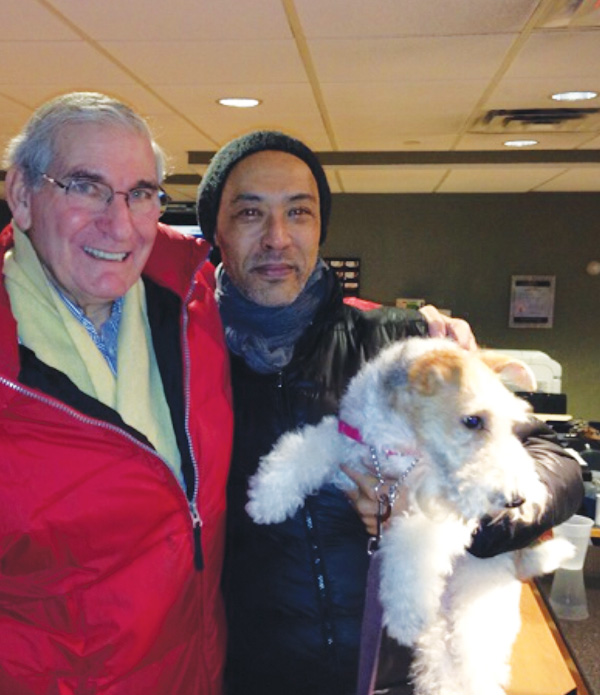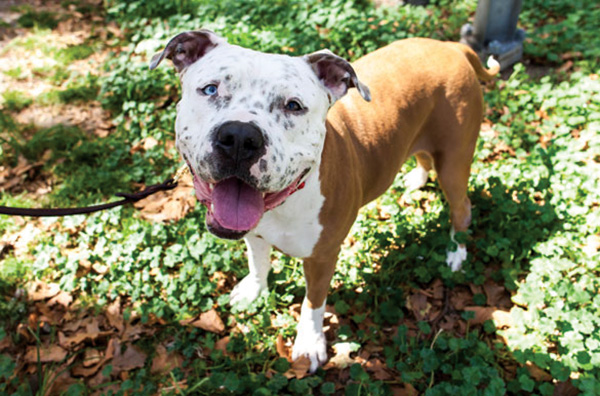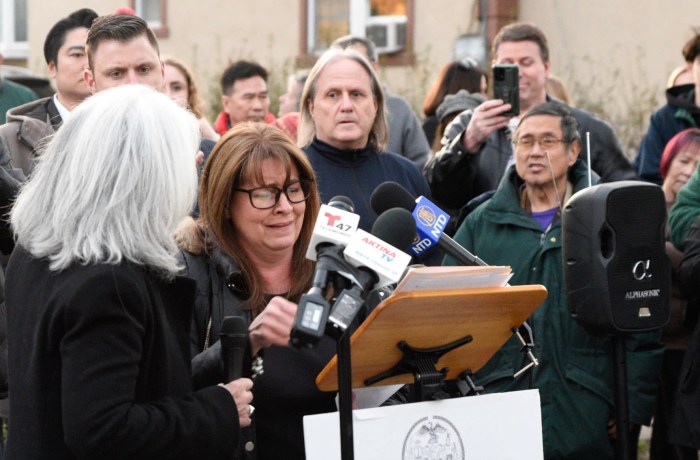
Quick thinking on the part of Morris Borock (left) and other helpful humans orchestrated a happy reunion between Orlando Straughter and his wirehaired fox terrier, Fritz.
BY DUSICA SUE MALESEVIC | A group of Good Samaritans, and microchip technology, helped to reunite a worried owner and his dog after they were separated during last month’s tragic shooting at the Home Depot in Chelsea.
Morris Borock, a 77-year-old Upper East Side resident (and the twin brother of Council of Chelsea Block Associations president Bill Borock), played a pivotal role in reuniting Fritz, a wirehaired fox terrier, and his owner Orlando Straughter, who lives in East Harlem.
At the Home Depot at 40 W. 23rd St. (btw. Fifth & Sixth Aves.), Borock had moved from the lighting department to another when he heard four or five shots ring out. Around 2:45 p.m. on Sun., Jan. 25, an employee, 31, used a .38 caliber revolver to shoot his supervisor, 38, who died after being rushed to Bellevue Hospital.
“People started running out of the store,” Borock told Chelsea Now by phone. “For some reason, I felt calm. I don’t know why.”
Borock attribute his placid demeanor to being in the army at one time. He left through the front entrance of the store.
The police came seven to ten minutes later, said Borock, and after they entered the store, more shots were heard. “That’s when the perpetrator killed himself,” Borock commented.
After the second set of shots, a dog — without a collar — came running out of the store.
“I was able to catch the dog,” recalled Borock. “I was holding the dog. It was petrified, it was shaking.”
Borock sat down at the front of the building and waited for about half an hour for the owner to show up — but they would end up missing each other.
Straughter had gone to Home Depot that day for light bulbs. He had been walking down an aisle when he heard a “Pow Pow, not thinking anything of it — ’cause things fall and accidents happen,” he told Chelsea Now by phone. “So I assumed that it was like, someone dropped light bulbs. And then after another five minutes, you hear another four gunshots. As then I look up, I’m looking at people — it was like slow-motion mode — and people walking toward me, then all of sudden running.”
He had bent down to pick up Fritz when he was knocked down by a second wave of people. In the melee, the dog got out of his leash. Moving with the crowd, he ended up exiting at the store’s empoyee entrance on W. 22nd St. He kept calling his dog’s name and could see him through the glass door, said Straughter.
“Then all of sudden he disappeared, so I was frantic,” he recalled.
Straughter decided to go to the front entrance on W. 23rd St.
But by that time, Borock had taken the suggestion of a woman in the crowd and they both took the dog to the New York Dog Spa & Hotel (dogspa.com) at 32 W. 25th St., two blocks away from Home Depot.
Frances Scott, the Dog Spa manager, said that they brought the dog in to see if perhaps it was a regular customer that staff could recognize.
Fritz wasn’t familiar, Scott said in a phone interview, but he was a “friendly, sweet” dog and “he wanted to play.”
Scott put out some water for Fritz and gave a leash to Borock. She wanted to send them to a veterinarian so that a wand could read the dog’s microchip, but it was Sunday and many were closed.
A microchip, about the size of a grain of rice, is usually inserted between the shoulder blades in the back of a pet, said Steve Gruber, director of communications for the Mayor’s Alliance for NYC’s Animals (animalalliancenyc.org), an organization that has been encouraging the practice for the past ten years by hosting low-cost microchipping events.
Gruber said in a phone interview that the procedure is usually painless.
Scott said that a lot of owners use microchips for their pets, noting that it is difficult to find a lost dog in the city.
She called Fifth Avenue Veterinary Specialists, located at 1 W. 15th St., and talked with the receptionist, who said to bring the dog in.
Fifth Avenue Veterinary Specialist (vcaspecialtyvets.com/fifth-avenue) is open 24 hours, seven days a week and when Borock and Fritz got there, it was crowded, he said. But the vet had a wand that could scan the chip. Once scanned, information shows up on the wand itself.
The information revealed where the dog had been bred, but not the owner’s phone number or name. They called the breeder, who gave the name of a pet shop in Westchester County. They then called the pet shop, which give them the information they needed, said Borock.
Meanwhile, Straughter remained outside of the Home Depot entrance. He approached an officer and described Fritz and the situation. The cop told him to wait with the reporters across the street.
“I’m still thinking that Fritz is still roaming in the Home Depot,” he said.
After waiting for around two and a half hours, Straughter spoke with another officer, who said he had walked the floor of the store and didn’t see a lost dog.
“By this time my heart throbbed,” he said. “Maybe he ran out of Home Depot and now he’s loose in Chelsea. Maybe someone picked him up and then I’ll never see him again.”
Straughter said he decided to go to the Petco, at 890 Broadway in Union Square, which he frequents and “on the way there I’m looking at everyone and their dog.” When he walked inside, his phone rang and it was the receptionist at the Fifth Avenue Veterinary Specialists saying that they had Fritz.
“I bolted out of Petco, ran into the clinic,” he said. “I just immediately got emotional. I hit the floor on my knees and just started crying emotionally and thanking [Borock] relentlessly. It was so amazing. It was [a] godsend that this all happened like it did.”
Jennifer Kelly Newman, hospital manager, told Chelsea Now in an email statement, “It was such a joy for everyone…to help reunite Fritz with his owner. Fifth Avenue Veterinary Specialists is honored to have taken part in such a touching story!”
“Fritz came out and he just ran into my lap,” said Straughter. “It was just amazing that [Borock] did what he did out of the kindness of his heart.”
When asked why he went out of his way to help, Borock responded, “I’m just that type of person.”
Borock said that he found money on the street and was able to track down the owner to return it. He ran after a thief who had robbed a person who had just taken money out of an ATM.
“I’m just that type of person that if something happened to me, I would want someone to help me out,” he explained.
While talking with Chelsea Now, Borock, a social worker, was watching his daughter’s dog, Coconut. He has never owned a dog, but being around his daughter’s dog has been “an amazing experience.”
“I know now the definition of a lap dog. They crawl up on your lap, they put their head down and they fall asleep. I live in New York, the only pets I’ve had have been mice and roaches before,” he said with a laugh.

Frieda was adopted last week, but many others remain at the ASPCA, in need of loving homes. See aspca.org/nyc/adoptable-dogs or visit the NYC shelter, at 424 E. 92nd St.
HOW TO HELP A LOST DOG
Dr. Emily Weiss, vice president of research and development for the ASPCA (aspca.org), talked to Chelsea Now by phone about how to approach a lost dog. Weiss said that a common mistake people make is that they approach quickly and use what she termed “human communication,” i.e., full frontal posture — walking toward a dog tall and straight.
“If a dog is fearful, all of those things are likely to push the dog further away,” she said.
Weiss suggested “canine communication,” meaning you turn your body to the side, which connotes in canine terms that you have no intention to fight. Also, do not look at the animal directly, but rather use peripheral vision, kneel down and coax the dog to come to you as opposed to trying to grab or catch the animal.
Be really cautious about street traffic, said Weiss, when approaching a lost dog.
“Being thoughtful about how is that dog responding — is he moving towards me or away from me,” she said.
The ASPCA recommends both an ID tag and microchipping. Weiss said that an ID can be read by anybody and that a pet owner should put their cell number, home number and a phone number of a friend just in case they happen to be out of town.
An ID tag is “really the easiest way and most expedient way” to find a pet, she said.
With microchipping, Weiss said it is important that the chip provider has the most up-to-date information for the owner.
“Just having your pet microchipped isn’t enough. You need to make sure that the information with the microchip provider is updated so that people can find you,” she said.
Steve Gruber, director of communications for Mayor’s Alliance for NYC’s Animals, also stressed keeping information updated. His organization has low-cost microchipping events throughout the year. For more information, visit animalalliancenyc.org.
The ASPCA offers a free resource app for pet owners. Go to aspca.org/blog/new-aspca-iphone-android-app-provides-essential-resource-pet-parents for more information.

















